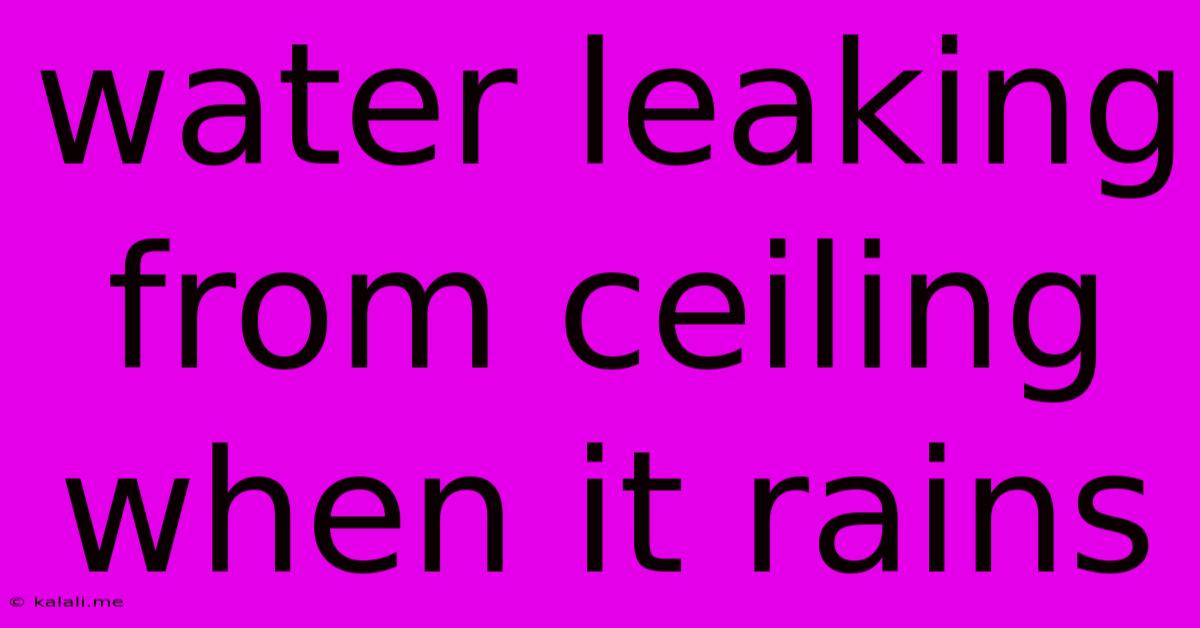Water Leaking From Ceiling When It Rains
Kalali
May 21, 2025 · 4 min read

Table of Contents
Water Leaking from Ceiling When It Rains: Causes, Solutions, and Prevention
A leaky ceiling during rainfall is a frustrating and potentially damaging problem. This comprehensive guide will explore the common causes of ceiling leaks during rain, offer effective solutions, and provide valuable prevention tips to safeguard your home. Ignoring a leak can lead to costly repairs down the line, including mold growth and structural damage, so addressing the issue promptly is crucial.
Common Causes of Rain-Induced Ceiling Leaks
Several factors can contribute to water leaking through your ceiling when it rains. Identifying the root cause is the first step towards effective repair.
-
Damaged Roofing Materials: This is the most frequent culprit. Cracked, missing, or deteriorated shingles, tiles, or other roofing materials allow rainwater to penetrate the roof structure. Age and wear, exposure to extreme weather, and poor installation can all contribute to this damage.
-
Blocked Gutters and Downspouts: Clogged gutters prevent rainwater from flowing away from your house, leading to overflows that can seep into the roof and walls. Leaves, debris, and even nests can cause blockages. Regular gutter cleaning is essential.
-
Flashing Issues: Flashing is a waterproof material used around chimneys, vents, and skylights to create a seal. Damaged or improperly installed flashing allows water to penetrate these vulnerable areas. Rust, cracks, and gaps are common problems.
-
Chimney Problems: Cracks or gaps in the mortar around your chimney can allow water to seep into the structure. A damaged chimney cap can also lead to leaks.
-
Roof Ventilation Problems: Poor roof ventilation can lead to moisture buildup, which can saturate the roofing materials and eventually cause leaks. This is especially problematic in areas with high humidity.
-
Damaged Roof Underlayment: This protective layer beneath the shingles is crucial for waterproofing. Tears or damage to the underlayment will allow water to reach the roof decking and eventually leak through the ceiling.
-
Penetrations in the Roof: Any opening in the roof, such as improperly sealed pipes or electrical conduits, can create entry points for rainwater.
Diagnosing the Leak: A Step-by-Step Guide
Pinpointing the exact location of the leak is crucial for effective repair. Follow these steps:
-
Locate the Leak: Carefully examine the ceiling to identify the exact point where the water is leaking. Mark the location with tape.
-
Check the Attic: If possible, access your attic and investigate the area above the leak. Look for signs of water damage, such as staining, dampness, or sagging.
-
Inspect the Roof: Carefully examine your roof from the ground and, if safely accessible, from the roof itself. Look for damaged shingles, missing tiles, blocked gutters, or other visible problems.
-
Consider Professional Help: If you are unable to locate the source of the leak, it's best to call a qualified roofing contractor. They have the experience and equipment to diagnose and repair even the most difficult leaks.
Solutions and Repairs
The repair method will depend on the identified cause of the leak:
-
Roofing Material Repair: Damaged shingles or tiles need to be replaced. This may involve patching minor damage or a more extensive roof repair.
-
Gutter and Downspout Cleaning: Thoroughly clean your gutters and downspouts to remove any debris and ensure proper drainage.
-
Flashing Repair: Replace or reseal any damaged flashing to restore the waterproof seal.
-
Chimney Repair: Repair or replace damaged mortar around the chimney and ensure the chimney cap is intact.
-
Roof Ventilation Improvement: Improve roof ventilation by installing additional vents or ensuring existing vents are clear.
-
Underlayment Repair: Repair or replace damaged roof underlayment to restore the waterproof barrier.
-
Seal Roof Penetrations: Seal any openings in the roof with appropriate caulking or sealant.
Preventing Future Leaks: Proactive Measures
Regular maintenance is key to preventing future ceiling leaks. Consider these preventative measures:
-
Regular Roof Inspections: Inspect your roof at least twice a year, particularly after severe weather events.
-
Gutter Cleaning: Clean your gutters and downspouts twice a year, or more frequently in areas with lots of trees.
-
Roof Maintenance: Address any minor roof damage promptly to prevent it from escalating into a major problem.
-
Proper Ventilation: Ensure adequate roof ventilation to prevent moisture buildup.
By understanding the causes of rain-induced ceiling leaks and taking proactive steps, you can protect your home from water damage and the associated costs. Remember, prompt action is crucial to prevent further damage and maintain the integrity of your home.
Latest Posts
Latest Posts
-
Fleas In House But No Animals
May 21, 2025
-
Traffic Sign Red Cross Blue Background
May 21, 2025
-
Key Stuck In Lock Half Turned Upvc Door
May 21, 2025
-
Until When Can You Pray Fajr
May 21, 2025
-
What Does Going Down On Someone Mean
May 21, 2025
Related Post
Thank you for visiting our website which covers about Water Leaking From Ceiling When It Rains . We hope the information provided has been useful to you. Feel free to contact us if you have any questions or need further assistance. See you next time and don't miss to bookmark.